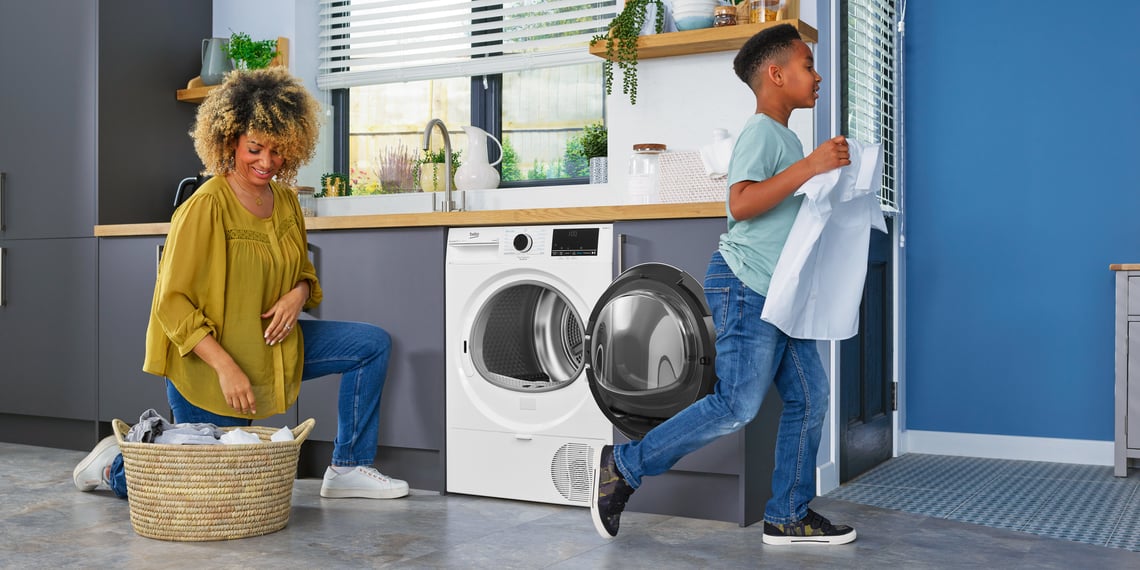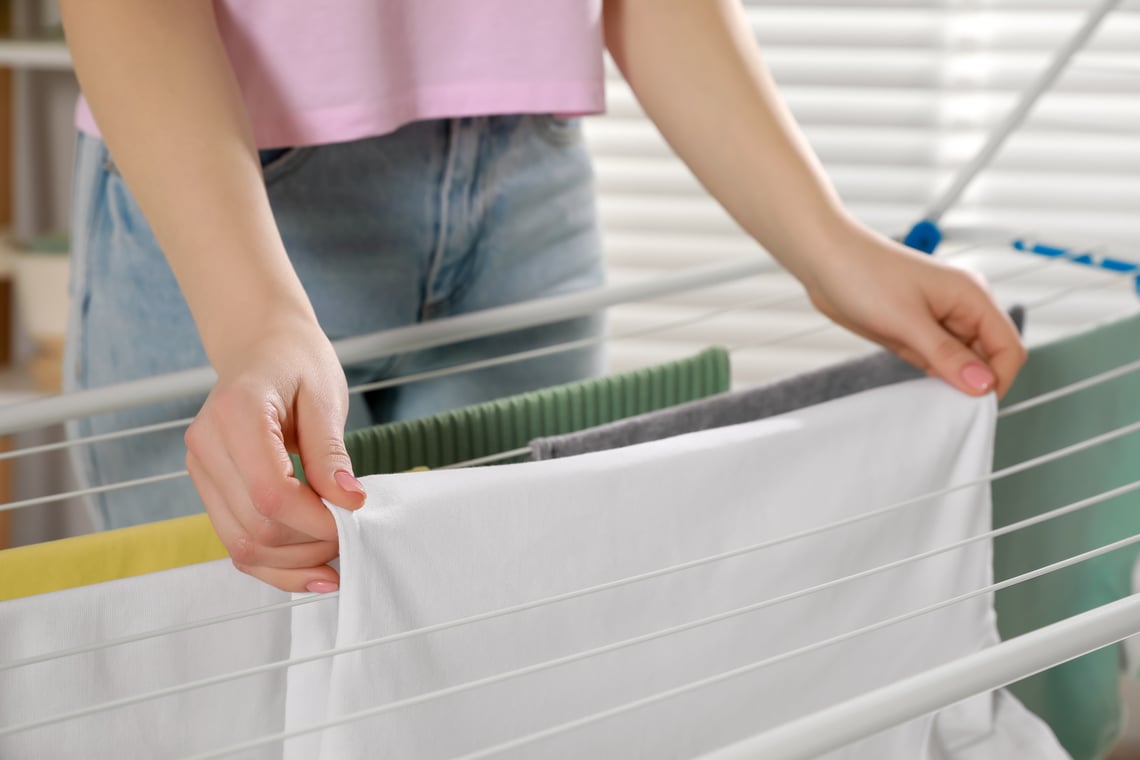How to Effectively Dry Clothes in Winter: Air Dry vs Tumble Dry

Winter brings unique challenges for drying clothes, as the cold, damp weather can make outdoor drying nearly impossible. Our research shows that there are about 40 dry days between January and March that allow for drying clothes outside. This leaves you with two main options: air drying indoors or using a tumble dryer. Each method has its pros and cons, especially during the colder months.
Air drying is energy-efficient and gentle on your clothes, helping them last longer. However, it can take much longer for clothes to dry indoors, and managing space and humidity can be tricky. On the other hand, tumble drying is quick and convenient, particular in the winter months. However, it comes with higher energy consumption and may cause wear and tear on your fabrics over time. Finding the right balance between efficiency, energy use, and fabric care is key to finding the best solution for drying your clothes in winter.
In this blog, we’ll guide you through both options, so you can make the most practical and cost-effective choice.
Understanding tumble dryer energy consumption in winter
Tumble dryers offer convenience, especially in winter when outdoor drying is rarely an option. However, their energy consumption tends to increase during the colder months.
As the dryer works to evaporate moisture from clothes, it requires more energy, particularly if the air inside your home is colder. Frequent use of a tumble dryer can lead to higher energy bills, making it essential to consider energy-efficient models and optimise dryer settings. By choosing a dryer with a good energy rating and using programmes such as Eco, you can reduce consumption. Additionally, drying full loads rather than partial ones and cleaning the lint filter regularly can further improve efficiency.
Air drying clothes indoors: benefits and challenges
Air drying indoors is an attractive option for many, as it eliminates energy costs and is gentler on fabrics. This method is especially beneficial for delicate items that may shrink or wear out in a tumble dryer. However, air drying comes with its own set of challenges in winter. Space limitations can make it difficult to hang clothes indoors, especially in smaller homes, and drying times are also longer. Moreover, wet clothes in the home can increase the damp in your property by around 30%, leading to mould and mildew, and potential health issues. Using a dehumidifier or regularly opening windows can help maintain air quality while your clothes dry.
Clothes drying solutions for small spaces
If you’re short on space, there are practical solutions for drying clothes indoors. Compact drying racks that can be folded away when not in use are ideal for small homes. Wall-mounted drying racks, over the bath or retractable lines can also save floor space. For those who prefer a tumble dryer, consider a compact, slim, or stackable model that fits neatly into small laundry rooms or even kitchens.
Tumble dry vs air dry: which is more energy-efficient?
In terms of energy efficiency, air drying takes the lead, as it requires no electricity. However, in winter, drying clothes indoors can increase humidity, potentially leading to higher heating costs if you need to ventilate more often. Tumble dryers, though energy-intensive, can be more efficient if you use them wisely. Opting for lower heat settings, drying full loads, and choosing an energy-efficient model, such as a heat pump tumble dryer rather than a condenser, can help reduce costs.
Pros and cons of air drying indoors in cold weather
Air drying indoors during winter has its pros and cons. On the positive side, it saves energy and is gentle on clothes, preserving fabric quality. However, it can lead to increased indoor humidity, which may cause condensation and mould if not managed properly, putting your health and that of your home at risk. Drying times are also much longer, which can be inconvenient, especially if you have limited space to hang clothes.
Tips for efficient indoor clothes drying

Drying clothes indoors during winter doesn’t have to be a hassle. Whether you’re air drying or using a tumble dryer, these tips can help you optimise the process:
Air Drying Tips:
- Location is key: Place clothes near a sunny window to speed up drying times.
- Improve air circulation: If natural heat is limited, use a fan to help moisture evaporate faster.
- Manage indoor humidity: Drying clothes indoors can lead to excess moisture. Use a dehumidifier to control moisture levels and prevent mould, or open windows periodically to allow fresh air in.
Tumble Drying Tips:
- Maintain your dryer: Clean the lint filter after every load to ensure efficient drying and reduce the risk of fire.
- Avoid overloading: Dry full loads, but don’t stuff the drum, as this can hinder performance.
- Use dryer balls: They help separate clothes, improving airflow and reducing drying time.
- Optimise settings: Experiment with "eco" or "low heat" settings to save energy without compromising on performance.
- Consider sensor drying: If you have a newer model, use the sensor drying technology to automatically stop when clothes are dry, preventing over-drying and saving energy.
These small adjustments can make a big difference in drying performance, energy consumption, and the longevity of your clothes, ensuring a more efficient and cost-effective winter laundry routine.
Both air drying and tumble drying have their merits and challenges during the winter months. By weighing the pros and cons and considering your household’s needs, you can choose the most effective method for drying clothes this winter.
FAQs
How can I reduce tumble dryer energy consumption in winter?
To reduce energy use, opt for Eco or "low heat" programmes and dry full loads. Regularly clean the lint filter for efficiency, and consider upgrading to an energy-efficient model, such as a heat pump tumble dryer. Avoid overloading the dryer to prevent increased energy consumption. Additionally, try to group similar fabrics together to optimise drying time. Consider air drying heavier items first and then finishing them in the dryer to reduce overall energy use.
Is it safe to air dry clothes indoors during winter?
It is generally safe to air dry clothes indoors during winter, but make sure to manage humidity levels to prevent condensation and mould. If you have allergies or respiratory issues, pay extra attention to the humidity in your home and avoid sleeping in the same room where clothes are drying. Use a dehumidifier or ventilate the room occasionally by opening windows, especially if drying in small spaces. Position clothes in well-ventilated areas, such as near a window or a fan, to reduce drying time. It’s also helpful to rotate clothes halfway through drying to ensure even moisture evaporation.
What are the best ways to dry clothes indoors without a tumble dryer?
Use compact drying racks, wall-mounted options, or heated airers. Place clothes near the window for direct sunlight, and improve air circulation with a fan to speed up drying. You can also use hangers to dry shirts and blouses, freeing up space on drying racks. For faster results, roll wet clothes in a towel and press out excess water before hanging them to dry.
Can air drying indoors increase humidity levels?
Yes, it can increase humidity by 30%. To control humidity, use a dehumidifier or ventilate your space by opening windows. Keep an eye on condensation to avoid mould growth. If you notice consistent humidity issues, consider drying clothes in smaller batches to minimise moisture buildup. Using moisture-absorbing products, such as silica gel, can also help manage indoor humidity levels.
Which method is better for delicate fabrics in winter?
Air drying is best for delicate fabrics, as it's gentler and avoids the risks of shrinkage or damage. If you must use a tumble dryer, choose a low heat setting and use a mesh laundry bag for protection. Laying delicate items flat on a drying rack can also help maintain their shape. Additionally, avoid direct heat sources, which can warp or shrink delicate materials.



